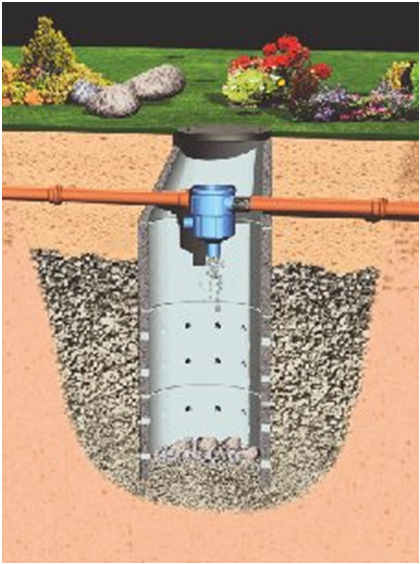Soakaways are buried chambers that store surface water and allow it to soak into the ground. They are typically square or circular excavations either filled with rubble or lined with brickwork, pre-cast concrete or polyethylene rings/perforated storage structures surrounded by granular backfill. The supporting structure and backfill can be substituted by modular, geocellular units.
Soakaways provide storm water attenuation, and storm water treatment. They also increase soil moisture content and help to recharge groundwater, thereby offering the potential to mitigate problems of low river flows. They store rapid runoff from a single house or from a development and allow its efficient infiltration into the surrounding soil. They can also be used to manage overflows from water butts and other rainwater collection systems, or can be linked together to drain larger areas including highways.
As a sub-surface infiltration device, a soakaway requires no net land take. They can be built in many shapes and can often be accommodated within high-density urban developments, and can also be retro-fitted. Soakaways are easy to integrate into a site, but offer very little amenity or biodiversity value as they are underground features and water should not appear on the surface.

Principle of a soakaway
Source: Andras Kis’ presentation, NWRM Workshop 1
| Benefits | Level |
|---|---|
|
ES1 - Water storage
|
Low
|
|
ES5 - Climate change adaptation and mitigation
|
Low
|
|
ES6 - Groundwater/aquifer recharge
|
High
|
|
ES7 - Flood risk reduction
|
High
|
|
ES9 - Filtration of pollutants
|
Low
|
|
PO2 - Improving status of physico-chemical quality elements
|
Low
|
|
PO4 - Improving chemical status and priority substances
|
Low
|
|
PO5 - Improving quantitative status
|
Medium
|
|
PO7 - Prevent surface water status deterioration
|
Low
|
|
PO8 - Prevent groundwater status deterioration
|
Low
|
|
PO9 - Take adequate and co-ordinated measures to reduce flood risks
|
High
|
|
PO11 - Better protection for ecosystems and more use of Green Infrastructure
|
Low
|
|
BP1 - Store runoff
|
Medium
|
|
BP6 - Increase infiltration and/or groundwater recharge
|
High
|
|
BP7 - Increase soil water retention
|
Low
|
|
BP8 - Reduce pollutant sources
|
Low
|
|
BP9 - Intercept pollution pathways
|
Low
|
